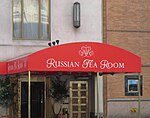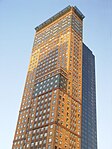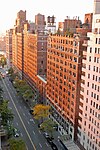165 West 57th Street

165 West 57th Street, originally the Louis H. Chalif Normal School of Dancing headquarters, is a building in the Midtown Manhattan neighborhood of New York City. It is along the northern sidewalk of 57th Street between Sixth Avenue and Seventh Avenue. The five-story building was designed by George A. and Henry Boehm for dance instructor Louis H. Chalif. It was designed as an event space, a school, and Chalif's apartment. 165 West 57th Street has an asymmetrical facade. The original ground story was originally built with ivory-colored Dover marble but was later refaced with limestone. At the second and third stories, the facade contains a diagonal pattern resembling a diamond, with terracotta molding. Inside were a ballroom at the second story (later known as the Carl Fischer Hall, Judson Hall, or CAMI Hall) and a dining area at the third story. The fourth floor has terracotta panels and windows; it was originally used as Chalif's family residence. The fifth floor, used as an event space, has a loggia behind a colonnade. The building is topped by an overhanging cornice and an asphalt roof. Construction started in 1914 and was completed in 1916. The building was occupied by the Louis H. Chalif Normal School of Dancing until 1932 or 1933. Three clients were listed as occupying the building until 1937, after which it remained vacant for five years. The Federation of Crippled and Disabled moved its headquarters to the building in 1943 and operated there for several years. Carl Fischer Music acquired the building in 1946 and had a shop and performance hall there until 1959, when it was sold to Columbia Artists Management Inc (CAMI). The New York City Landmarks Preservation Commission designated 165 West 57th Street as a city landmark in 1999. It was sold to the Clover Foundation in 2007 and has been occupied by IESE Business School since then.
Excerpt from the Wikipedia article 165 West 57th Street (License: CC BY-SA 3.0, Authors, Images).165 West 57th Street
West 57th Street, New York Manhattan
Geographical coordinates (GPS) Address Nearby Places Show on map
Geographical coordinates (GPS)
| Latitude | Longitude |
|---|---|
| N 40.765544 ° | E -73.979289 ° |
Address
One57
West 57th Street
10019 New York, Manhattan
New York, United States
Open on Google Maps









